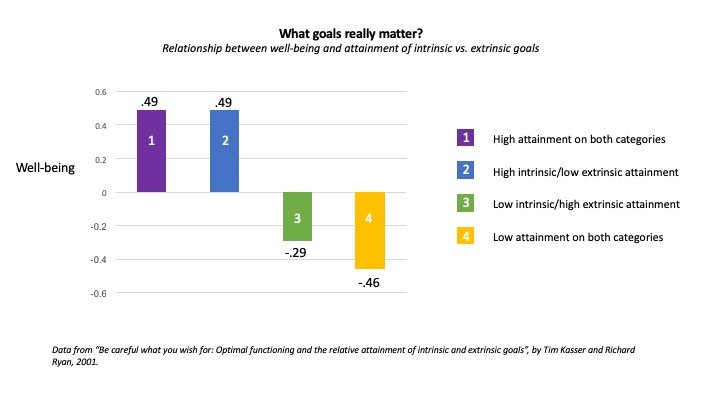Why you might be successful but unhappy (+ the chart that made me gasp)
I was sitting on a plane, reading a kind-of-dry book, when I saw a chart that made me gasp.
My husband, sitting next to me, asked to see what had made me react like that. So I showed him, and his eyes widened, too.
“I can see why you gasped,” he told me.
Here’s the chart, and I’ll explain what it means in a second:
This chart is based on a study by Tim Kasser and Richard Ryan, in 2001. They were interested in the relationship between attaining certain kinds of goals and people’s well-being. In particular, they distinguished between two types of goals: extrinsic vs. intrinsic.
Extrinsic goals include wealth or admiration or fame. They are things that we do because we like how they make others view us.
Intrinsic goals includes personal growth, close relationships, and community contributions. Typically, intrinsic goals feel good in-and-of-themselves, whether or not they impress or please others.
It’s worth naming that any given goal could be either intrinsic or extrinsic, depending on your motivation. For example, someone could play the piano simply because they love it (an intrinsic goal), or because their parents said they have to (an extrinsic goal).
In this study, Kasser and Ryan asked college students how much they felt they had achieved extrinsic goals (money, fame, appearance) and how much they felt they had achieved intrinsic goals (personal growth, close relationships, community contribution.)
Then, they separated the college students into four different groups:
High achievement on both categories
High intrinsic achievement, low extrinsic achievement
Low intrinsic achievement, high extrinsic achievement
Low achievement on both categories
They also asked those college students about their personal well-being — which they calculated by asking them about things like self-actualization, anxiety, and depression.*
So, back to that chart again:
Two things made me gasp about this chart:
1. Attaining extrinsic goals doesn’t really matter for well-being.
Look at groups 1 and 2. There was virtually no difference in well-being between students who had achieved bothextrinsic and extrinsic goals (group 1), versus students who had achieved intrinsic goals only (group 2).
2. But if you haven’t attained intrinsic goals, your well-being suffers.
I think that group 3, in particular, is very interesting. Those students had high achievement of extrinsic goals, but low achievement of intrinsic goals. If you saw them, you might see them as attractive or successful. But they had terrible well-being!
In fact, there’s not a ton of differences between students in group 3 (high extrinsic achievement, low intrinsic achievement) and group 4 (low achievement on both). A small difference, to be sure — it’s better to achieve something than nothing at all — but not as much as you’d think.
…
The reason that I gasped when I saw this study was because even though I’ve heard all of the classic reminders that “being beautiful or successful can’t buy happiness” and “good relationships are what matters most,” I can still find myself wanting to achieve “impressive” things, on some level. Don’t you?
I had never seen, in such stark terms, how little those things actually matter for well-being.
And so, here’s my offering for this week: Have you reflected on your goals lately? How many of your goals are intrinsic? How many are extrinsic?
* Technically, Kasser and Ryan compared goal attainment, on the x axis, and “correlation with well-being” on the y-axis in their original study, but Kasser, in The High Price of Materialism, simplified “correlation with well-being” to “well-being,” and I’ve chosen to do the same here.
(For anyone that’s curious, I originally saw this chart in Tim Kasser’s The High Price of Materialism, p. 44-46. I fully understood the study by going back to Kasser and Ryan’s original paper summarizing the data, which you can access here.)
As always, I’m rooting for you. You’ve got this.
Katie
If this essay resonated with you, you'll love my newsletter. Sign up for free + get new ideas every Sunday!


